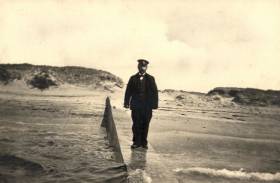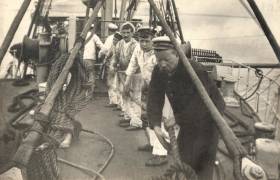Displaying items by tag: Irish Lights Exhibition
#Exhibition – An exhibition that captures the history of The Commissioners of Irish Lights is on display in Dublin and concurrently in Wexford County Council HQ as previously reported on Afloat (but ends tomorrow, Sunday 5 March). The exhibitions are free of admission, though an accompanying illustrated booklet costs €5.
The Safety at Sea through War and Upheaval: Irish Lights 1911-1923 exhibition in conjunction with the Royal Irish Academy had begun touring nationwide last year firstly in Cobh. The same exhibition is also now on display in Dublin. The venue is the Coach House of Dublin Castle and will run until April.
The exhibition explores the history of the island of Ireland itself, its ever-changing coasts and shorelines, and the history of the people who lived along our island’s seaboard. Through the nineteenth century the number of Ireland’s lighthouses increased from fourteen to seventy-four, with eleven lightships placed around the east and south coasts.
Also explored is the origins of Irish Lights in the late-eighteenth century, and coming of age in the certainties of the nineteenth, faced the challenges of global and national uncertainty in the early twentieth century. Precisely, the exhibition details Irish Lights’ history between 1911 and 1923.
The exhibition charts through the years of incredible events, such as; the Easter Rising of 1916, the Anglo-Irish War of 1919–1921, and the Anglo-Irish Treaty.
What emerges is a never-before told story of devotion to duty, scientific, engineering and physical endeavour, world war, revolution and change.
It is also a deeply personal story of those who worked with and built up Irish Lights. Those who devoted their lives to protecting the coastline for the safety of all which remains to the present day and by keeping abreast of future technological developments.
Touring Exhibition: Safety at Sea through War and Upheaval: Irish Lights 1911-1923
#Exhibition - The Commissioners of Irish Lights and the Royal Irish Academy continues to tour an exhibition around our coastline that captures the history of Irish Lights.
Having first exhibited last year in Cobh as Afloat reported on the next venue will be Wexford at the town’s County Office HQ and is scheduled from 23 January-5 March. The location is at Carricklawn (close to Wexford General Hospital) on the (R769) road that leads west out of the town.
The history of the island of Ireland itself, its ever-changing coasts and shorelines, and the history of the people who lived along our island’s seaboard. Through the nineteenth century the number of Ireland’s lighthouses increased from fourteen to seventy-four, with eleven lightships placed around the east and south coasts.
The exhibition explores how Irish Lights, with its origins in the late-eighteenth century, and coming of age in the certainties of the nineteenth, faced the challenges of global and national uncertainty in the early twentieth century. Precisely, the exhibition details Irish Lights’ history between 1911 and 1923.
Also explored in the exhibition through these years are the incredible events, such as; the Easter Rising of 1916, the Anglo-Irish War of 1919–1921 and the Anglo-Irish Treaty.
What emerges is a never-before told story of devotion to duty, scientific, engineering and physical endeavour, world war, revolution and change.
It is also a deeply personal story of those who worked with and built up Irish Lights. Those who devoted their lives to protecting the coastline for the safety of all which remains to the present day and by keeping abreast of future technological developments.






























































